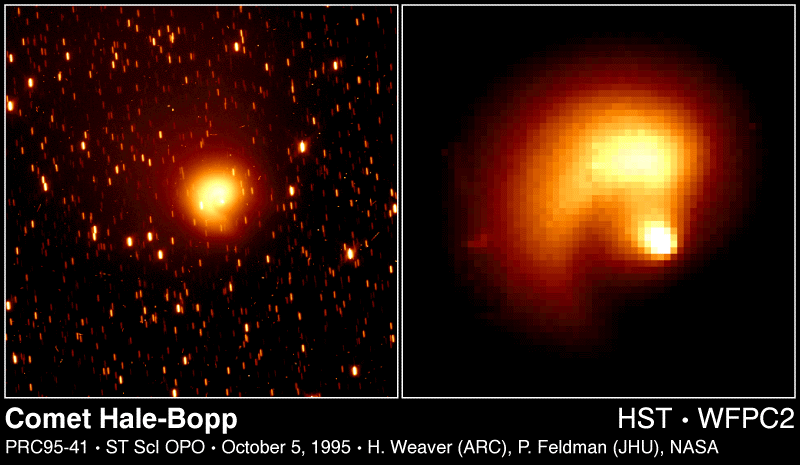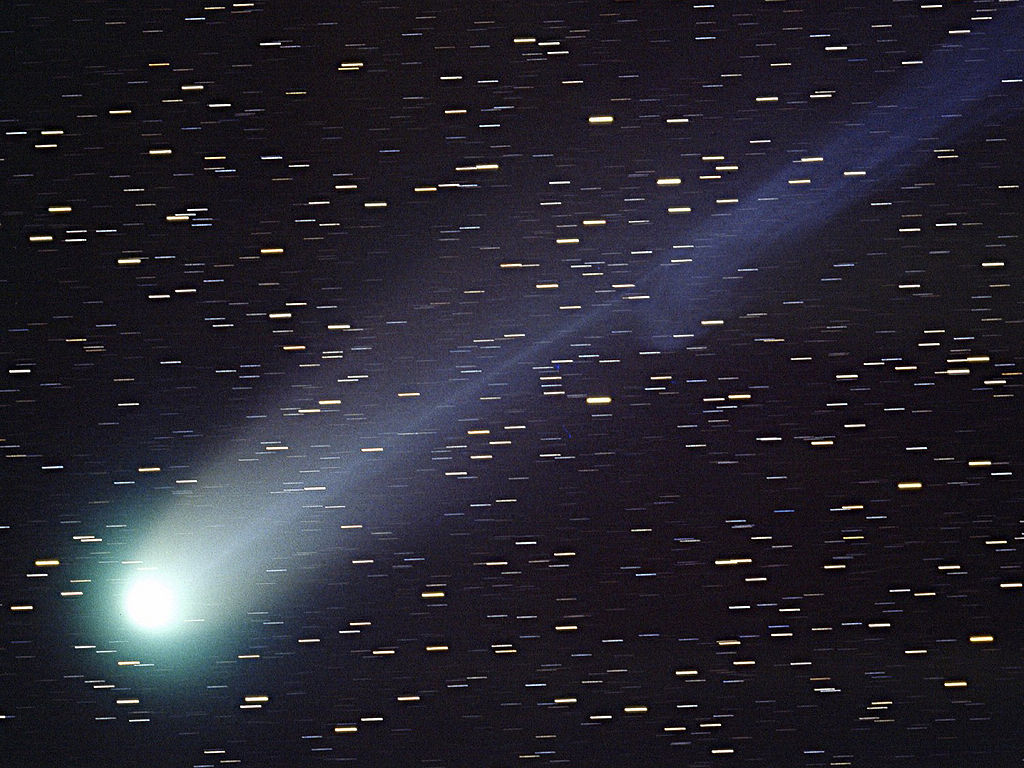1. Halley’s Comet

Halley’s Comet, otherwise known as Comet Halley is a short-period comet visible from Earth every 75–76 years. Halley’s Comet is the only known short-period comet that is regularly visible to the naked eye from Earth, and the only naked-eye comet that might appear twice in a human lifetime.
The first observations and recordings of the comet was in 240 BC, with the most recent sighting in the inner parts of the Solar System in 1986. The next time that that the comet will appear visible to those on Earth will be in mid-2061 to 2062. During its 1986 apparition, Halley’s Comet became the first comet to be observed in detail by spacecraft, providing the first observational data on the structure of a comet nucleus and the mechanism of coma and tail formation. Haley’s Comet is famous for being visible to most by the naked eye during its approach and its short orbital period.Its officially designation is 1P/Halley.
2.Hale-Bopp

Hale-Bopp is perhaps the most widely comet observed of the 20th century and one of the brightest seen for many decades. The comet was named Hale-Bopp for both its discoverers, Alan Hale and Thomas Bopp discovered Comet Hale–Bopp separately on July 23, 1995 before it became visible to the naked eye. Both Hale and Bopp were amateurs who were looking at the nights sky and realized they had discovered an unknown object and notified the astronomical bodies of the discovery.
It is possible that the previous perihelion may have been observed in ancient Egypt during the 6th dynasty reign of the Pharaoh Pepi II. When Hale Bopp came into the solar system in 1997, the comet’s orbit was shortened considerably by Jupiter’s gravity to a period of roughly 2,533 years, and it will next return to the inner Solar System around the year 4385. It is worth noting that the comet’s current orbit is almost perpendicular to the plane of the ecliptic, which will not only explain the effect that Jupiter would have on the comet, but also why the comet might not come closer to the Earth in the future. Other designations for the comet include The Great Comet of 1997, and C/1995 O1. It is worth noting that there is a tragic side to the story of Hale-Bopp, as about 40 people from the “Heaven’s Gate” cult committed mass suicide as the comet approached Earth.
3.Swift Tuttle

Swift Tuttle Comet 109P/Swift-Tuttle takes 133 years to orbit the Sun once. Swift-Tuttle last reached perihelion (closest approach to the Sun) in 1992 and will return again in 2125.
Swift-Tuttle is a large comet -- its nucleus is 16 miles (26 kilometers) across. (That is more than twice the size of the object hypothesized to have led the demise of the dinosaurs.)
The pieces of space debris that interact with our atmosphere to create the popular Perseids meteor shower originate from Swift-Tuttle. This annual meteor shower takes place each August, and peaks mid-month. It was Giovanni Schiaparelli who realized in 1865 that this comet was the source of the Perseids.
When comets come around the Sun, the dust they emit gradually spreads into a dusty trail around their orbits. Every year the Earth passes through these debris trails, which allows the bits to collide with our atmosphere where they disintegrate to create fiery and colorful streaks in the sky.
4. Shoemaker Levy-9

Shoemaker-Levy 9 was discovered in 1993, it already had been torn into more than 20 pieces traveling around Jupiter in a two-year orbit. Further observations revealed the comet (believed to be a single body at the time) had made a close approach to Jupiter in July 1992 and had been torn apart by tidal forces resulting from the planet's powerful gravity. The comet was thought to have been orbiting Jupiter for about a decade before its demise.
The disruption of a comet into multiple fragments was rare, and observing a captured comet in orbit about Jupiter was even more unusual, but the biggest and rarest revelation was that the fragments were going to smash into Jupiter.
NASA had spacecraft in position to watch – for the first time in history – a collision between two bodies in the solar system.
NASA's Galileo orbiter (then still en route to Jupiter) captured unprecedented direct views as the string of fragments labeled A through W smashed into Jupiter's cloud tops. The impacts started on July 16, 1994, and ended on July 22, 1994.
5.Hyakutake

Hyakutake comet was discovered on 30 January 1996,[1] by Yuji Hyakutake, an amateur astronomer from southern Japan.[6] He had been searching for comets for years and had moved to Kagoshima Prefecture partly for the dark skies in nearby rural areas. He was using a powerful set of binoculars with 150 mm (6 in) objective lenses to scan the skies on the night of the discovery.[7]
This comet was actually the second Comet Hyakutake; Hyakutake had discovered comet C/1995 Y1 several weeks earlier.[8] While re-observing his first comet (which never became visible to the naked eye) and the surrounding patch of sky, Hyakutake was surprised to find another comet in almost the same position as the first had been. Hardly believing a second discovery so soon after the first, Hyakutake reported his observation to the National Astronomical Observatory of Japan the following morning.[9] Later that day, the discovery was confirmed by independent observations.[citation needed]
At the time of its discovery, the comet was shining at magnitude 11.0 and had a coma approximately 2.5 arcminutes across. It was approximately 2 astronomical units (AU) from the Sun.[10] Later, a precovery image of the comet was found on a photograph taken on January 1, when the comet was about 2.4 AU from the Sun and had a magnitude of 13.3.[5]